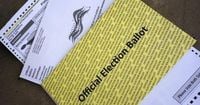President Donald Trump’s latest move to overhaul American voting has ignited a fierce national debate, particularly in states where mail-in ballots are a longstanding tradition. On August 18, 2025, Trump announced on his social media platform and in public remarks that he would issue an executive order to eliminate mail-in voting and certain in-person voting machines ahead of the 2026 midterm elections. The announcement, which Trump framed as an effort to restore "honesty and integrity" to the electoral process, has been met with both sharp criticism and vocal support, revealing deep divisions over the future of voting in the United States.
Mail-in voting, which allows voters to cast their ballots from home and send them in by mail or dropbox, has become an increasingly common method of participation in American democracy. According to the U.S. Election Assistance Commission, mail voting comprised 30.3 percent of turnout in the 2024 election, down from the pandemic-driven high of 43 percent in 2020 but still significantly higher than pre-pandemic levels. About one-third of all voters currently use mail-in voting, and in eight states—California, Colorado, Hawaii, Nevada, Oregon, Utah, Vermont, and Washington—plus Washington, DC, all elections are conducted entirely by mail. Of these, only Nevada and Utah voted for Trump in 2024, according to election data cited by BBC News.
Trump’s rationale? He claims mail-in ballots are "corrupt" and susceptible to fraud, and that voting machines are "Highly Inaccurate, Very Expensive, and Seriously Controversial," costing ten times more than alternatives like "Watermark Paper." In a Truth Social post, Trump asserted, "I am going to lead a movement to get rid of MAIL-IN BALLOTS… And also, while we’re at it, Highly ‘Inaccurate,’ Very Expensive, and Seriously Controversial VOTING MACHINES." He added, "You will never have an honest election if you have mail-in." He also argued that states are merely "an 'agent' for the Federal Government in counting and tabulating the votes" and "must do what the Federal Government, as represented by the President of the United States, tells them, FOR THE GOOD OF OUR COUNTRY, to do."
Legal scholars and election officials, however, have pushed back hard on Trump’s legal theory. As BBC News reported, the U.S. Constitution clearly gives states the authority to determine the "time, place and manner" of elections, with Congress having the power to "make or alter" rules for federal elections. UCLA election law professor Rick Hasen called Trump’s interpretation "wrong and dangerous," writing, "The Constitution does not give the President any control over federal elections." Most experts agree that Trump cannot unilaterally tell states how to conduct voting, and any executive order to ban mail-in ballots would likely be challenged in court.
That’s not stopping Trump or his supporters from pressing the issue. Trump’s campaign to eliminate mail-in ballots comes on the heels of a March executive order that sought to require proof of citizenship to vote, ban the counting of ballots received after election day, and increase federal oversight of state voting rules. That order was quickly blocked by federal judges, and White House lawyers are now reportedly adapting their approach in response to ongoing legal challenges, as reported by Megyn Kelly’s AM Update.
The Pacific Northwest, where mail-in voting is deeply entrenched, has emerged as a flashpoint in the debate. Oregon has conducted nearly all of its elections by mail for almost 30 years, and Washington state began its journey with mail-in voting in 1983, adopting universal vote-by-mail in 2011. Attorney General Dan Rayfield of Oregon emphasized the bipartisan support for mail-in voting in his state, saying, "If you look at the history of our secretary of states that have served, even Republican Dennis Richardson, talked about the values about mail-in voting." Secretary of State Tobias Read echoed that sentiment: "Fraud is exceedingly rare. And it has never affected the outcome of an election. Nonetheless, we're always looking for ways to make our system more secure… We have the most secure, fairest, most accurate elections in the entire country."
Washington Senator Maria Cantwell also weighed in, stressing, "We can’t be for suppressing the vote. Vote-by-mail is the consistently most safe and trackable method of voting." Representative Andrea Salinas of Oregon was even more direct: "Once again, Donald Trump is trying to destroy our democracy by undermining the will of the people. This time, he’s attacking mail-in voting." She pointed out that mail-in voting is critical for millions of Americans, including servicemembers and people with disabilities. Representative Suzanne Bonamici, also from Oregon, accused Trump of "authoritarian efforts" to deny Americans their right to vote, adding, "Donald Trump fears that he and MAGA Republicans can’t win on the merits so he is threatening to eliminate vote-by-mail elections, something he does not have the authority to do." Senator Ron Wyden, another Oregon Democrat, took to social media to ask, "Now Donald Trump is taking advice from Vladimir Putin on how to conduct elections? How about Trump ask voters here in Oregon and other states with vote-by-mail how it’s long been proven as a secure, effective & easy way for Americans to vote from home?"
But not everyone is convinced mail-in voting is flawless. Michael Hammerson, an Oregon resident, is spearheading a petition to end vote-by-mail in her state and aims to gather 15,000 to 20,000 signatures to put the issue on the November 2026 ballot. Hammerson argued, "When you have a ballot that is mail-in, it can be intercepted at numerous different points in that delivery process either to or from the voter. In addition to that, there's no telling who filled out the ballot… It's not that there are not problems with our elections. It's that we don't have the tools to detect those problems."
Arizona Secretary of State Adrian Fontes dismissed Trump’s fraud claims as "bonkers," noting that "mail-in balloting is secure and accurate and the preferred method for well over three-quarters of Arizona’s voters, not to mention the way that all voters in Washington and other states vote." Fontes said if Trump attempted to ban mail-in voting by executive order, he would "tell the president to 'pound sand,'" and work with the state attorney general to sue.
Recent events have added to the sense of urgency and controversy. In October 2024, arson attacks on ballot drop boxes in Oregon and Washington destroyed or damaged hundreds of ballots, though the fires were quickly contained in some cases thanks to suppression systems and security personnel. The suspect remains at large, and authorities believe the incidents are connected. Meanwhile, Trump’s attacks on voting machines come just two years after Fox News reached a $787 million settlement with Dominion Voting Systems over false claims that the company rigged its machines for Democrats. Fox is currently embroiled in a similar lawsuit with Smartmatic.
Globally, Trump’s claim that the U.S. is the only country with mail-in voting has also been debunked. According to the International Institute for Democracy and Electoral Assistance, 34 countries allow some form of mail-in voting, and 12—including Canada, Germany, and South Korea—allow all voters to vote by mail in their elections.
With the 2026 midterms on the horizon, the battle lines are drawn. As legal challenges loom and political rhetoric intensifies, the future of mail-in voting—and, by extension, the shape of American democracy—remains uncertain.





